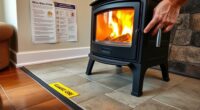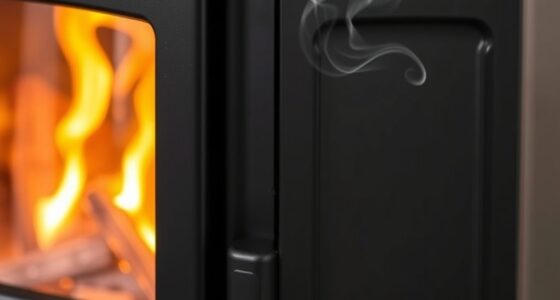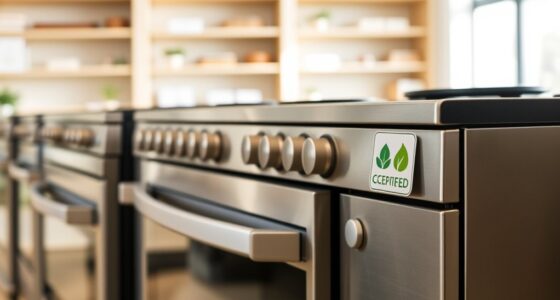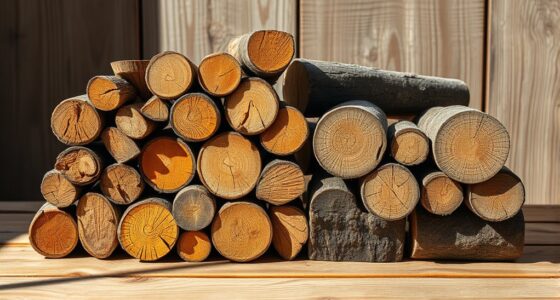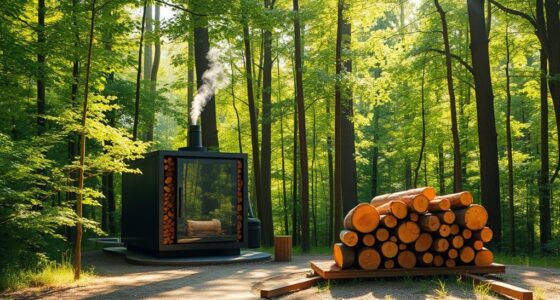When you burn wood, it releases gases like carbon monoxide, nitrogen oxides, and VOCs, along with tiny particles known as particulate matter. Inefficient burning or wet wood leads to more pollution and health risks, such as respiratory problems. These emissions also include smoke and ash, which can persist in the air and environment. Understanding what’s released helps you reduce pollution and stay safe—continue to explore how combustion impacts your health and the planet.
Key Takeaways
- Burning wood releases pollutants like carbon monoxide, nitrogen oxides, volatile organic compounds, and particulate matter, impacting air quality.
- Incomplete combustion from moist or green wood increases emissions of unburned particles and toxic gases.
- Properly seasoned, dry wood burns more efficiently, reducing harmful emissions and maximizing heat output.
- Fine particulate matter from wood smoke can cause respiratory issues and long-term health problems.
- Better stove design and maintenance help minimize emissions and promote cleaner, safer burning practices.
The Combustion Process and Its Emissions

When you burn fuel, the combustion process releases not only energy but also various emissions. Understanding wood chemistry helps explain how combustion efficiency influences what’s emitted. Wood contains cellulose, lignin, and moisture, which affect how completely it burns. Higher combustion efficiency means more complete oxidation of these components, reducing leftover residues and unburned particles. When combustion is efficient, fewer pollutants are released, and more energy is extracted from the same amount of wood. Proper combustion techniques can also reduce the production of harmful particulate matter. Additionally, optimizing combustion conditions ensures cleaner burning and fewer emissions. Conversely, poor combustion results in incomplete burning, producing smoke and unburned particles. Recognizing how wood chemistry impacts combustion efficiency enables you to optimize burning practices, minimizing harmful emissions and maximizing heat output. Additionally, using well-seasoned wood improves combustion efficiency, leading to fewer emissions and more effective heat generation.
Gases Released During Wood Burning

As wood burns, various gases are released into the atmosphere, impacting air quality and environmental health. Carbon monoxide is a common emission, which can be dangerous when inhaled in enclosed spaces. Additionally, wood ash contains residual gases that can release particles over time, affecting nearby air quality. The combustion process also produces other gases like nitrogen oxides and volatile organic compounds, which contribute to pollution. Here’s a quick look:
| Gas or Substance | Effect / Importance |
|---|---|
| Carbon Monoxide | Toxic, causes health issues in high concentrations |
| Wood Ash | Contains residual gases, can release particles |
| Nitrogen Oxides | Contribute to smog and respiratory problems |
| Volatile Organic Compounds | Contribute to smog and environmental pollution |
Understanding these gases helps you better grasp wood’s environmental impact. Additionally, the combustion process can vary depending on the moisture content of the wood and the efficiency of the burning method. A more efficient combustion process reduces the emission of harmful gases and improves overall air quality. Properly managing emissions during combustion can significantly lessen their negative effects. Recognizing the pollutant emissions produced during burning can help mitigate their effects on air quality and health.
Particulate Matter and Its Effects

Particulate matter (PM) consists of tiny particles released during wood burning that can easily become airborne and inhaled. These smoke particles are a major component of air pollution from burning wood, affecting your health and the environment. When you burn wood, PM can settle in your lungs, causing respiratory issues, especially if you’re exposed regularly. Fine particles can penetrate deep into your respiratory system and even enter your bloodstream, increasing health risks like asthma, bronchitis, and heart problems. Air pollution from smoke particles also contributes to smog formation, reducing air quality in your community. Recognizing these effects helps you understand the importance of proper wood-burning practices and pollution control measures to protect yourself and others from the harmful impacts of particulate matter. Additionally, understanding Honda Tuning can offer insights into how emissions are managed and minimized in modern vehicle systems, emphasizing the importance of technological advancements in reducing pollution. Moreover, advancements in automated monitoring technologies can help detect and control particulate emissions more effectively, further reducing environmental and health impacts. Being aware of these air quality issues highlights the necessity of adopting cleaner combustion techniques and pollution mitigation strategies. Implementing air purification methods, such as using effective filters and ventilating properly, can also help reduce indoor exposure to harmful particles.
Factors Influencing Emission Levels

Several factors directly influence the level of emissions produced during wood burning. Efficiency factors, such as the design of your stove or fireplace, determine how completely the wood burns. Better efficiency means more complete combustion, reducing harmful emissions. Moisture content is another critical factor; wet or green wood contains more water, which causes incomplete burning and increases emissions of pollutants like smoke and particulate matter. Dry, seasoned wood burns more efficiently, producing fewer emissions. The type of wood also matters, as hardwoods generally burn cleaner than softwoods. Properly seasoned wood with low moisture content enhances combustion efficiency and minimizes emissions. Additionally, using properly maintained appliances ensures optimal burning conditions and further reduces pollutants released during your wood-burning activities.
Impacts on Health and Environment
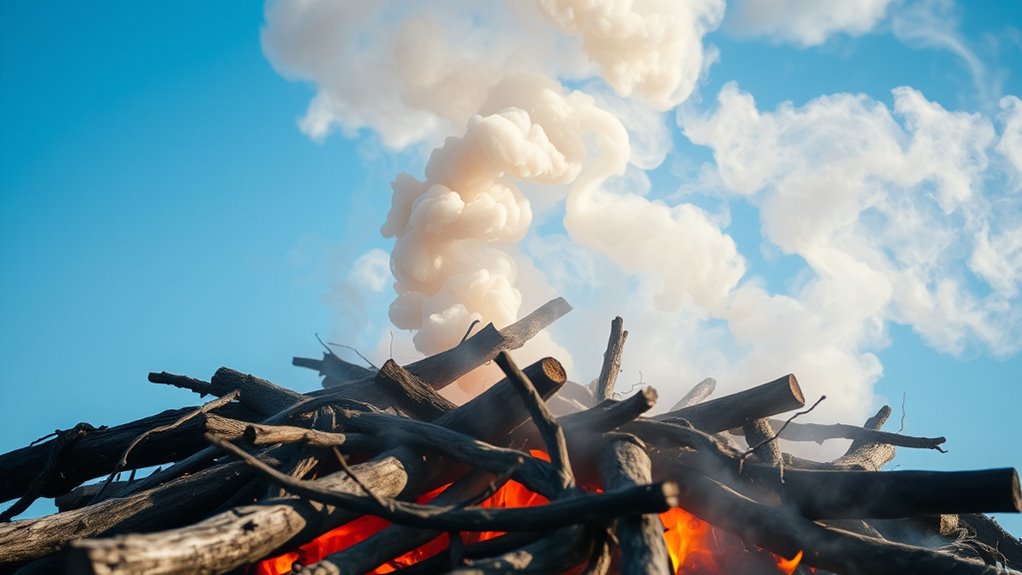
Burning wood releases pollutants that can harm both your health and the environment. These emissions, like particulate matter and volatile organic compounds, can reduce indoor air quality, leading to respiratory issues and allergies. Long-term exposure increases risks of asthma and other illnesses. Environmentally, burning wood contributes to your carbon footprint because it releases carbon dioxide, adding to greenhouse gases that drive climate change. While wood is renewable, improper burning or inefficient stoves can emit higher pollutant levels, worsening air pollution and affecting ecosystems. Ensuring proper ventilation and stove operation helps reduce these impacts. Promoting emission reduction techniques and using cleaner-burning appliances can significantly lower pollutant release. Additionally, selecting efficient heating systems can further decrease emissions and improve energy use. Being mindful of how you burn wood helps protect your health and minimizes your environmental footprint, especially when considering the impact on ecosystems, making your use of wood as sustainable and safe as possible. Furthermore, adopting advanced combustion technologies can substantially improve emission outcomes.
Frequently Asked Questions
How Can I Reduce Emissions When Burning Wood at Home?
To reduce emissions when burning wood at home, you should focus on clean burning practices. Use well-seasoned, dry wood to guarantee complete combustion, which minimizes smoke and harmful emissions. Invest in a modern, efficient stove or fireplace designed for emission reduction, and maintain it regularly. Proper airflow and avoiding overloading also help improve combustion, making your wood burning cleaner and more environmentally friendly.
Are There Safer Types of Wood to Burn Environmentally?
You’re wondering if there are safer, more eco-friendly woods to burn. Opt for sustainably harvested or eco-friendly woods like hardwoods with low sap content, such as oak or maple, which produce less smoke and emissions. Consider using wood alternatives like compressed wood pellets or bamboo, which burn cleaner and are more sustainable. Always choose seasoned, dry wood to minimize pollutants and maximize efficiency, helping the environment while enjoying your fire.
What Are the Long-Term Environmental Impacts of Wood Burning?
You might wonder about the long-term impacts of wood burning. It contributes to climate change through greenhouse gases and accelerates forest degradation, harming ecosystems and reducing biodiversity. Over time, increased deforestation weakens forests’ ability to absorb CO2, further fueling climate change. Your continued use of wood as fuel can worsen these effects, so considering sustainable options helps protect the environment and maintain healthy forests for future generations.
How Does Moisture Content Affect Emission Levels From Wood?
Imagine a damp forest whispering its secrets as you burn wood; moisture content plays a vital role. Higher moisture levels increase emissions, making it harder to control pollutants. To achieve emission control, moisture reduction is essential—dry wood burns cleaner, releasing fewer harmful gases. By choosing seasoned wood, you help reduce emissions, making your fire more efficient and eco-friendly. Your mindful choices directly impact air quality and the environment.
Can Emissions From Wood Burning Be Effectively Filtered or Captured?
You can effectively filter or capture emissions from wood burning through air purification and emission control technologies. Using devices like electrostatic precipitators, catalytic converters, or high-efficiency particulate air (HEPA) filters diminishes harmful pollutants released into the air. Proper installation and maintenance of these systems guarantee cleaner emissions, helping you minimize environmental impact and improve air quality around your burning area.
Conclusion
Understanding what’s released when you burn wood helps you make better choices. Did you know that wood smoke contains over 100 different chemicals, including harmful pollutants? By being aware of these emissions, you can reduce your health risks and environmental impact. Simple steps like using dry, seasoned wood and proper stove maintenance can markedly cut emissions. Stay informed and responsible—your actions can make a real difference for cleaner air and a healthier planet.


